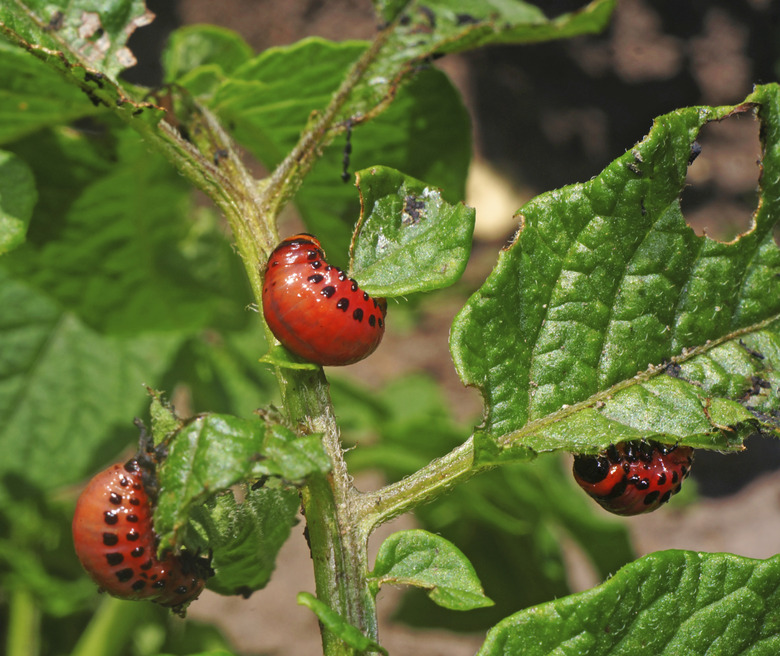Red Bugs On The Tomato Plants
The best that can be said about red bugs on tomato plants (*Lycopsersicon esculentum*) is that they don't clash too much with their surroundings. Two of the four tomato-infesting red bugs are barely visible to the naked eye, and the others outgrow their coloring in a few weeks. Without quick treatment, however, the damage they cause can have you seeing red with each visit to the tomato patch.
Step 1
Pinprick-sized red dots scurrying about on the backs of tomato leaves are two-spotted spider mites. They've come to your tomato to drain its leaves of nutrient-rich sap, spin fine white webs and lay their eggs. *Mite-infested leaves become stippled and bronzed from loss of chlorophyll.* They often fall prematurely, exposing the fruit to sunburn. Spider mites are *most likely to show up under hot, dry dusty conditions.* When their feeding causes one tomato to deteriorate, the female mites ride wind currents to healthy ones. **Without early elimination, spider mites can take out an entire tomato crop.**
Spider Mite Control
Step 1
Control small spider-mite populations easily and organically by **rinsing them off with a hose-sprayer attachment set to sharp spray.** Make sure to wet the backs of the leaves. Rinse the tomatoes every two or three days while hot, dry conditions persist. *Wetting down the soil around the plants to control dust helps curb new infestations.* **Treat stubborn mite populations with ready-to-use insecticidal soap.** It suffocates them on contact, so the soap must *thoroughly cover their feeding sites on the back of the leaves.* On a dry, calm day when the temperature is below 90 degrees Fahrenheit and no rain is expected for at least 24 hours, spray the plants until they drip. Repeat every one or two weeks, or as often as the brand label suggests, until the mites are gone. *Before spraying, dress in protective clothing, including a long-sleeved shirt, long pants, safety glasses, waterproof gloves and a respiratory mask.*
Step 2
- Control small spider-mite populations easily and organically by **rinsing them off with a hose-sprayer attachment set to sharp spray.
- ** Rinse the tomatoes every two or three days while hot, dry conditions persist.
- *
Leaf-Footed Bug Nymphs
Step 1
Red leaf-footed bug nymphs resemble spider mites on steroids. They attack tomatoes in spring to drink the fluids from developing fruit. Their feeding *aborts very young tomatoes, and causes sunken areas or yellow spots on older ones.* **Eliminating the nymphs is much easier than controlling the adult bugs.** As soon as they appear, *brush them off the plants into a container of soapy water.* Use a battery-operated vacuum to suction off large colonies, and dispose of the dust-cup contents in a sealed plastic bag. **Wear gloves when removing the nymphs, because they release an unpleasant odor when disturbed.**
Colorado Potato Beetle Nymphs
Step 1
Black-headed, red-bodied Colorado potato beetle nymphs hatch in early spring from eggs deposited on the backs of tomato leaves. They chew large holes in the leaves. Control both adults and larvae by handpicking them from the leaves early in the morning when they're lethargic, and drowning them in soapy water. Shaking them onto a drop cloth before drowning also works. Spraying with ready-to-use insecticidal soap kills the soft-bodied larvae, but isn't effective against adults or eggs. Monitor the yellow eggs on the backs of the leaves, and spray immediately after they begin to hatch. Check daily for new eggs and repeat the treatment until all the larvae are gone.
Step 2
- Black-headed, red-bodied Colorado potato beetle nymphs hatch in early spring from eggs deposited on the backs of tomato leaves.
- Spraying with ready-to-use insecticidal soap kills the soft-bodied larvae, but isn't effective against adults or eggs**.
- Monitor the yellow eggs on the backs of the leaves, and spray immediately after they begin to hatch.
Red Aphids
Step 1
Although one red aphid is too small to notice, aphids almost never arrive on tomatoes alone. Most of the long-legged, pear-shaped pests are born as pregnant females, and each generation gives birth to the next in about a week. *Look for colonies of the insects crowding the stems and leaf backs,* where they steal nitrogen-rich sap and **excrete honeydew, their sticky, transparent waste.** Infested tomatoes may drop their flowers or have stunted, curling new leaves. The honeydew often attracts ants or sooty mold that coats the plants in layers of greasy black. *Remove aphids with the same rinsing or insecticidal soap application that works on spider mites.*
References
- US Statewide IPM Online: Spider Mites
- UC Statewide IM Online: Pesticide Information — Active Ingredient, Soap
- UC Statewide IPM Online: Leaf-Footed Bug
- Toxic Free NC: Organic Solutions for Colorado Potato Beetles
- University of Maryland Extension: Insect Pests of Tomatoes http://extension.umd.edu/learn/insect-pests-tomato
- UC Statewide IPM Online: Aphids
